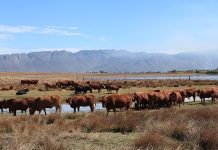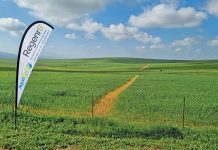The spectacular twists and folds in the Cape mountains. The forces involved in its formation are unimaginable.
It was a very clear morning. You could see to where the Atlantic Ocean disappeared over the horizon, almost 100km away. The view from 600m up Constantia Berg slope was stunning. We were making our best speed along the twisting 9km Chapman’s Peak road with its 114 curves, to be in time for our film shoot at Simonstown.
I was the trainer and handler of Dermot the hawk, one of the leading characters in the TV series The Adventures of Sinbad.
Suddenly an antiquated mechanical monster came around a sharp corner. It was an old, dilapidated truck in worse shape than I’d ever seen even in the old days in Mozambique. Passengers sat on top of the cab obscured by smoke and steam spewing from every orifice of its engine. A headlight dangled from a wire and each wheel buckled in a different direction. Objects hung underneath and trailed the truck on the ground. It was also loaded to the brim with agricultural produce in its wooden railed load bay, with a variety of livestock piled on top, and it made a noise that could be heard down to the Hout Bay docks.
I was dumbfounded such a monstrosity went unnoticed and tolerated on the road. was even more surprised when half-a-kilometer further a traffic cop sat casually on his bike chatting to someone. I pulled off the road and demanded to know why on earth the officer allowed the unroadworthy wreck to continue on the treacherous road; and severely reprimanded him for neglecting his public duty. W hen he just smiled, I was furious, but because of the unlikely possibility that he’d arrived after the truck had passed, started to describe its terrible condition to him with waving arms. Then the guy with him slowly turned and said, “Ag Omie, it’s part of another movie we’re making. You better hurry, I’ll see you later on the Sinbad set”.
M y pipe dropped from my mouth and the car stalled as they burst into laughter. Then recognised him as one of the technicians working with us on Sinbad. Since then the Chapman’s Peak road, hacked out of the mountain-side 90 years ago, was closed after a fatal rock-fall and subsequent lawsuit. was re-engineered with overhead protection for motorists.
Like Table Mountain, the top of Chapman’s Peak consists of flat sedimentary sandstone deposited on an ancient sea bed. The base of the mountain, however, consists of cape granite of volcanic origin and the two formations meet at an unstable geological inconformity often causing rock-slides.
The grandeur and beauty of mountains have through the ages fascinated humans often more than any other landscape. Mountains have always been places of mystery. To the ancient Greeks, Mount Olympus was the home of the gods and on Sinai Moses received the Ten Commandments. any people in east Africa believe God dwells on the snow-capped peak of Mount Kenya and thousands of pilgrims in Japan visit their holy mountain, Fujiyama, annually.
Wondrous creations that is a mountain really? Although no scientific definition exists, geographers classify mountains as prominent features on land, which rise to heights of 600m or more. can, however, not be disputed that a volcano rising 10 000m from the ocean floor in the Pacific is also a mountain. lthough mountains on land vary a great deal, one thing remains constant – the higher you go, the colder it gets. For every 100m the temperature drops by 0,5ºC and different kinds of plants and animals are found in each successive temperature belt, giving it a different character.
The way orogenesis (mountain building) takes place, determines the kind of mountain. There are several ways, but the only one we’re able to witness is that of active volcanoes. It’s a rapid process sometimes occurring in combination with other orogenetic processes.
V olcanoes are, however, not responsible for the formation of the great mountain ranges like the Rockies, Alps or the Himalayas. Those took millions of years or even hundreds of millions of years and were formed by movement in the earth’s crust too slow for us to see. We only see the results.
The Himalayas, for instance, were formed when the super-continent Gondwanaland broke apart and the Indian subcontinent drifted away from Africa and was thrust into the belly of Asia. The formations which make up the Himalayas consist of sandstone, laid down as sediment on the bottom of a shallow sea bed, which over time solidified into rock. When the continents were forced together, these sedimentary layers folded into wrinkles pushed skywards, to form the highest mountain chain on earth. If the folds were stretched out straight, it would increase the present width of the Himalayas by almost 650km. There is no doubt about this as fossilised marine creatures have been found even on the upper slopes of Mount Everest. It’s possible this process continues, but it’s too slow to measure.
The Fold Mountains of the Cape formed in a similar way. The flat sedimentary layers of sand, rounded stone and pebbles known as Enon Conglomerate, that originally existed in the area, were crushed into unbelievable folds and wrinkles by monumental forces unimaginable to us.
They formed mountain chains and peaks 140 million years ago, roughly three times higher than today. A period of high rainfall eroded them to their present shape and height. It can be seen in many places in the Cape mountains, but the Gamtoos Valley is a good example.
The layers in these types of mountains are like the pages of a book with the history of the earth written in rock. These layers often represent completely unique and different worlds that existed millions of years apart.
I often look in fascination at mountains like the Drakensberg, of which I have a wonderful view from my stoep, and try to imagine what those ancient worlds must have been like, and then I know the world is very old.
Due to its geological formation the Drakensberg is distinct and unique among mountain ranges. When the earth was young, almost the whole of South Africa was covered by lava. Due to erosion, layers of sandy sediment eventually came to rest, forming the sandstone characteristic of the eastern Free State. In time, those layers folded so sharply to form the mountain that the layers ruptured and fissures appeared through which basaltic lava spewed over the sediment.
The central part of the 1 000km mountain chain is as a result capped by layers of hard volcanic basalt about 1 400m thick with sandstone lower down, resulting in a combination of steep-sided blocks and sharp pinnacles. This resembles the spines on a dragon’s back. The Zulus call it uKhahlamba, the barrier of spears.
In the north where I live, quarts gravel formed the sediment, which solidified into much tougher quartsite and because the folding was gentler, the mountain never ruptured and there is no basalt topping. Further north magnificent castles of granite dominate. These beautiful sculptures, which fill me with awe, reach a climax at Matopos, the most beautiful place I’ve ever seen.
The flat bushveld north of Marikana and Rustenburg used to be decorated with the most beautiful little granite hills of spectacular boulders piled on top of each other. They were highlights in an otherwise featureless landscape and a magnate for wildlife. But they are no more; blasted to smithereens with dynamite by ruthless miners for a couple of bucks.
Human beings and mountains
I’m appalled by people’s disrespect for mountains. We who have been on earth for only a blip on the lifespan of the planet, must be the most destructive creatures ever to walk on its surface. We don’t hesitate to disfigure and scar these monuments of time simply to make new beer bottles, from which we take 10 sips before discarding them through windows, instead of reducing the damage by re-using them indefinitely.
We blast our lovely mountains to pieces for tiles and granite kitchen tops to keep up with the neighbours, but as soon as the fashion changes, they land as shattered rubble on rubbish dumps. The docks at our ports are piled up with huge granite and marble blocks to satisfy demand in Dubai, China and Japan to decorate boardrooms and office blocks that will be torn down in a few years to build bigger ones.
People and mountains often end up in the same place – the graveyard. When I die, please don’t break a mountain to make a tombstone for me. Just use a rough rock sculptured by nature if you feel you want to mark the spot. My name will soon be forgotten, but the damage to the mountain will remain for ever. – Abré J Steyn Contact Abré J Steyn on (015) 793 1356 or 083 235 4822 or e-mail [email protected]. |fw








